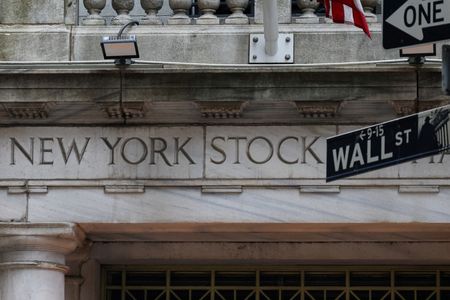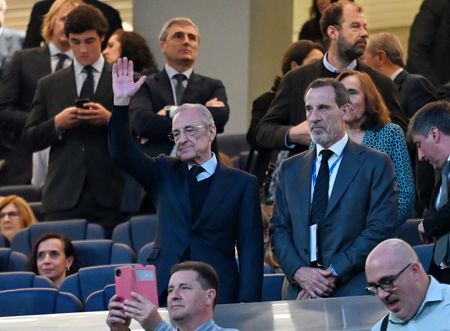By Anirban Sen and Isla Binnie
NEW YORK (Reuters) -Blue Owl Capital is considering reviving a plan to merge two of its private credit funds if the share price of the larger fund improves, as the alternative asset manager evaluates its options after facing investor backlash against the move last week, according to two people familiar with the matter.
The asset manager was forced to abandon a move to combine its publicly-traded OBDC fund and Blue Owl Capital Corporation II on Nov. 19 after a plan to merge the two funds, freezing withdrawals from the smaller fund and offering its holders the price of the larger fund, rattled investors.
The asset manager, which saw a strong reason for merging the funds in order to give shareholders an exit and reduce costs, at the time said it planned to reevaluate alternatives for the funds in the future and that it still saw merit in a deal.
The sources, who requested anonymity as the discussions are confidential, cautioned that nothing has been finalized and did not specify the timing of such a move.
Blue Owl’s plan came after investors had shown anxiety over credit in recent months, where a few high-profile bankruptcies have rattled confidence in credit quality. Private credit has attracted particular scrutiny despite executives trying to offer reassurance, pointing to default rates in the industry that remain relatively low compared to historical periods of market stress.
Reviving the deal, not previously reported, is contingent on the share price improving so that the OBDC fund is preferably not trading at a discount to its net asset value, the sources added, adding that any merger would be likely to happen before the privately-held OBDC II is due for a so-called liquidity event.
Such an event is expected to happen by the end of April 2026 or by the end of April 2027, according to a disclosure from the fund. A fund’s liquidity event would typically refer to a transaction that will cash out investors, executives and employees, through options including a sale or IPO.
The sources did not state a specific share price target. When Blue Owl initially announced the merger, OBDC was trading at a discount to the net asset value of its holdings, meaning that investors in Blue Owl Capital Corporation II were faced with potential losses of about 20% in the value of their holdings, according to an investor presentation from Blue Owl and Reuters calculations.
Blue Owl’s OBDC fund disclosed on Nov. 5 when it announced the merger that its NAV per share for the third quarter was $14.89. The fund’s shares have traded as high as $15.73 and as low as $11.65 this year, and closed on Friday at $12.34.
In television interviews last week, Blue Owl co-president Craig Packer said the firm would consider all its options, including listing the fund or selling the assets.
“There may be other options that we may come up with in the next few months,” Packer said in a Bloomberg TV interview. The firm said on Wednesday it would allow investors to withdraw their money from the first quarter of 2026.
Packer said on Wednesday that while Blue Owl continues to believe in the merits of merging the two funds, the firm is “no longer pursuing the merger at this point given current market conditions.”
An independent initial public offering of Blue Owl Capital Corporation II, which is one of Blue Owl’s earliest private credit funds for retail investors, is unlikely to be pursued, the sources said, adding that a merger between the two funds is the most desired outcome for the firm and makes strategic sense given the considerable overlap in the portfolios of the two funds.
PRIVATE CREDIT BOOM
The private credit industry has witnessed an unprecedented boom in recent years, as non-bank lenders have seized on a once-in-a-generation opportunity to make large corporate loans and grab market share from traditional Wall Street lenders who have faced restrictions in making such loans due to tighter regulations.
The rapid growth of the industry has resulted in asset managers launching ways to bring private credit to ordinary investors. Blue Owl’s ability to bring its funds to a liquidity event where investors cash out is important to markets because it could help determine demand for such investments in the future.
As of Sept. 30, Blue Owl Capital Corporation II’s portfolio includes stakes in 190 companies worth $1.7 billion in aggregate, while OBDC holds investments in 238 companies that are collectively worth $17.1 billion according to a filing.
“The most accretive way to do it would be to merge (Blue Owl Capital Corporation II) with OBDC – it’s the best outcome for shareholders because there’s accretion in earnings. If OBDC trades close to book, there’s a real possibility that they’ll revisit it,” Mitchel Penn, a senior analyst who covers business development companies (BDCs) at Oppenheimer & Co, said in an interview.
Mergers between funds have been fairly common in the private credit industry in recent years. Last year, Carlyle’s publicly-traded credit fund Secured Lending struck a deal to take over the firm’s private Secured Lending III fund, the firm said. In 2019, Goldman Sachs merged its publicly-traded BDC with its privately-held Middle Market Lending Corp, it said in a press release.
(Reporting by Anirban Sen and Isla Binnie in New York; editing by Megan Davies)











